Expert Advice: Bagley Risk Management Approaches
Wiki Article
Recognizing Livestock Risk Protection (LRP) Insurance Policy: A Comprehensive Overview
Browsing the realm of animals threat protection (LRP) insurance policy can be a complicated endeavor for many in the farming industry. This kind of insurance offers a safeguard against market fluctuations and unpredicted conditions that could affect livestock manufacturers. By comprehending the intricacies of LRP insurance coverage, producers can make educated choices that may secure their procedures from financial dangers. From just how LRP insurance policy functions to the various insurance coverage options offered, there is much to discover in this extensive guide that could possibly form the means livestock manufacturers approach threat administration in their businesses.

Exactly How LRP Insurance Coverage Works
Sometimes, recognizing the mechanics of Animals Danger Defense (LRP) insurance can be intricate, but breaking down exactly how it works can give clarity for ranchers and farmers. LRP insurance policy is a risk management device made to shield livestock manufacturers versus unanticipated price decreases. The plan allows producers to set a protection level based on their certain needs, choosing the number of head, weight range, and coverage cost. When the policy remains in location, if market value fall below the protection rate, manufacturers can submit a case for the distinction. It is essential to note that LRP insurance is not a revenue warranty; rather, it focuses only on price threat defense. The protection duration usually varies from 13 to 52 weeks, giving versatility for producers to select a period that straightens with their production cycle. By using LRP insurance policy, farmers and ranchers can alleviate the financial threats linked with varying market value, guaranteeing greater stability in their procedures.Qualification and Insurance Coverage Options

When it comes to insurance coverage choices, LRP insurance policy supplies producers the adaptability to pick the protection level, protection period, and endorsements that best suit their threat management needs. By understanding the qualification requirements and insurance coverage choices available, livestock manufacturers can make enlightened choices to take care of threat effectively.
Pros and Cons of LRP Insurance Coverage
When assessing Animals Risk Protection (LRP) insurance, it is crucial for livestock producers to evaluate the advantages and drawbacks integral in this danger monitoring tool.
One of the key benefits of LRP insurance coverage is its capacity to supply protection versus a decrease in animals costs. This can assist secure producers from monetary losses arising from market changes. In addition, LRP insurance coverage provides a level of flexibility, enabling manufacturers to tailor insurance coverage levels and policy periods to suit their details needs. By locking in a guaranteed rate for their animals, producers can better manage danger and prepare for the future.
Nonetheless, there are additionally some disadvantages to take into consideration. One limitation of LRP insurance policy is that it does not safeguard against all sorts of risks, such as condition episodes or natural catastrophes. Costs can sometimes be costly, especially for producers with huge livestock herds. It is important for producers to very carefully assess their individual risk exposure and economic scenario to establish if LRP insurance is the right risk monitoring tool for their procedure.
Understanding LRP Insurance Coverage Premiums

Tips for Taking Full Advantage Of LRP Benefits
check these guys out Making best use of the benefits of Livestock Danger Defense (LRP) insurance coverage calls for helpful site tactical planning and proactive risk management - Bagley Risk Management. To maximize your LRP protection, consider the following suggestions:On A Regular Basis Evaluate Market Conditions: Remain educated regarding market trends and price changes in the animals industry. By monitoring these aspects, you can make educated choices concerning when to acquire LRP coverage to secure against possible losses.
Establish Realistic Insurance Coverage Degrees: When picking coverage degrees, consider your production prices, market price of livestock, and potential dangers - Bagley Risk Management. Establishing reasonable coverage degrees ensures that you are appropriately shielded without overpaying for unneeded insurance
Expand Your Insurance Coverage: As opposed to depending exclusively on LRP insurance policy, think about expanding your threat management strategies. Combining LRP with various other danger management devices such as futures contracts or choices can offer extensive protection versus market uncertainties.
Review and Change Protection Frequently: As market conditions transform, occasionally examine your LRP protection to guarantee it aligns with your current threat exposure. Readjusting coverage levels and timing of purchases can you can check here assist maximize your threat protection technique. By complying with these pointers, you can make best use of the advantages of LRP insurance and guard your livestock operation against unanticipated dangers.
Conclusion
In conclusion, livestock risk security (LRP) insurance policy is an important tool for farmers to handle the economic risks related to their animals procedures. By comprehending how LRP functions, eligibility and protection options, as well as the advantages and disadvantages of this insurance policy, farmers can make informed choices to safeguard their source of incomes. By meticulously considering LRP premiums and carrying out strategies to make the most of advantages, farmers can alleviate potential losses and make sure the sustainability of their procedures.
Livestock manufacturers interested in getting Animals Risk Security (LRP) insurance can check out a variety of eligibility standards and insurance coverage options tailored to their certain livestock operations.When it comes to protection alternatives, LRP insurance supplies manufacturers the versatility to pick the insurance coverage level, coverage duration, and endorsements that best match their risk administration demands.To understand the intricacies of Animals Risk Protection (LRP) insurance totally, comprehending the aspects influencing LRP insurance policy costs is vital. LRP insurance policy costs are determined by different elements, including the coverage degree picked, the anticipated price of animals at the end of the insurance coverage duration, the kind of livestock being guaranteed, and the length of the insurance coverage period.Testimonial and Readjust Protection Frequently: As market conditions alter, periodically review your LRP coverage to guarantee it lines up with your current threat exposure.
Report this wiki page